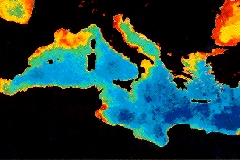Ocean Color Map (OCM) is a prototype service, based on Earth Observation products, designed to support users involved in eutrophication monitoring and fishery management and providing Chlorophyll concentration maps.
Many studies provided evidence of a deep correlation between several parameters (climate, physical and chemical conditions of the marine environment and food-chain processes) and fish’s spatial distribution and displacements.
The use of satellite data acquired by Water quality dedicated sensors has proven that plankton information, combined with other environmental data, can significantly improve the efficiency of the fish finding process.
SeaWiFS sensor data were used to produce Ocean Colour Maps for the African Countries in order to define a service for building tuna tracks within Mediterranean Sea and Near Atlantic Ocean.
Thanks to ENVISAT-1 MERIS data availability, Planetek Italia has improved the fish finding service by integrating higher spatial resolution ocean colour data with in situ data.
At the beginning the service was integrated under the framework of the MASS-SER-O2 project developed for the Ground Segment Department at ESA-ESRIN.
Actually the service provided by OCM is integrated into the Service Support Environment SSE ESA (the former MASS- Multiple Application Support Service System-). The SSE portal, is part of the eoPortal website, which provides links to many information sources by allowing the integration of wide range of heterogeneous EO and GIS services including catalogues of products.
SSE OCM serviceproduces Chlorophyll concentration maps over the user area of interest. The chlorophyll concentration is an indicator of phytoplankton biomass, the basis of the food chain in the oceans. Level 2B MERIS data contains values of Chlorophyll-a concentration and is used to generate maps indicating plankton pigment concentration expressed in mg/m3. The service allows to search and select one or more Ocean Colour products from the ESA catalogue, that then are made available via an FTP site for download.
Users involved in eutrophication monitoring and fishery management can take benefits using such service. Typical users are Coastal Municipalities, Authorized Ministries, Regional and Provincial Government, Authorized sanitary local unities, Fisheries cooperatives, Maritime department, Provincial divisions (ARPA, NOE, ANSA), Biologists and vets.




